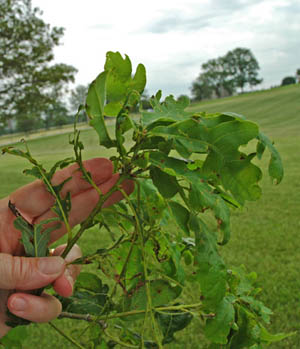Tattered Oaks | |
|---|---|
| June 19, 2008 | |
|
We have been receiving reports of tattered-looking oak foliage again this season at the University of Illinois Plant Clinic. We happened to look more closely at one of the oaks in the Plant Clinic lawn and found it was also affected. The image shows the foliage of our affected tree.  “Oak tatters” is a term coined for a condition that has occurred for over 20 years. This is not environmental scorching, which results in brown to black leaf margins. Instead, we are talking about foliage that looks as though it has been “eaten” by an insect. Only the major veins and a bit of tissue around the veins remain intact. Soft tissues of the leaves appear to have been eaten by a starved insect. The foliage is not scorched or necrotic. What is left on the leaf is green. The foliage appears lacy and the canopy appears thinned. We have heard reports of oak tatters in Illinois, Iowa, Indiana, Ohio, Michigan, Wisconsin, Minnesota, and Missouri. There are other problems that might resemble oak tatters. Anthracnose causes spring leaf damage but causes brown lesions on the foliage. This year has been a big year for anthracnose. Some insects cause similar damage, so look for the insects (usually caterpillars) or evidence of insects, including frass or webbing. Diseases and insects have been eliminated as causes of oak tatters. Current research points to chemical injury as the cause of oak tatters. In 2004, three researchers at the University of Illinois did a preliminary study that indicated that drift of chloroacetamide herbicides (possibly from applications onto corn and soybean fields) was a possible cause of the leaf tatters syndrome. The researchers are Jayesh Samtani, John Masiunas, and Jim Appleby. An article describing their work can be found in the Plant Health Progress On-line Journal, February 2005, at http://www.plantmanagementnetwork.org/sub/php/brief/2005/tatters/. This work was repeated and will be reported early next year. The group submitted an article to the Hort Science journal just last week. Another publication is in preparation. I spoke with Masiunas, and he said that they have consistently recreated symptoms of tatters after applying chloroacetamide herbicides to both white oak and red oak. Some of you may have seen tatters on hackberry. These researchers are less certain of the situation with hackberries. According to Masiunas it is more difficult to spray at specific growth stages with that host. They have not recreated symptoms on hackberry. There has been some concern that a tree repeatedly attacked by oak tatters might decline and even die. No evidence exists to confirm this theory, but the question merits investigation. The image in this article shows new foliage that has emerged without the tatters symptom next to older foliage with tatters. The tree seems to be recovering. You may help your trees by following good horticultural practices to promote tree health, especially watering in periods of drought stress. For more information, visit the US Forest Service pest alert on tatters at http://www.na.fs.fed.us/spfo/pubs/pest_al/oaktatters/oaktatters.htm. | |
| Author: | Nancy Pataky |
